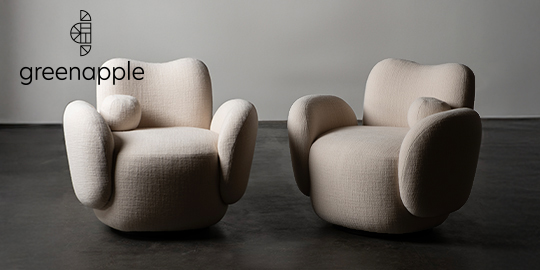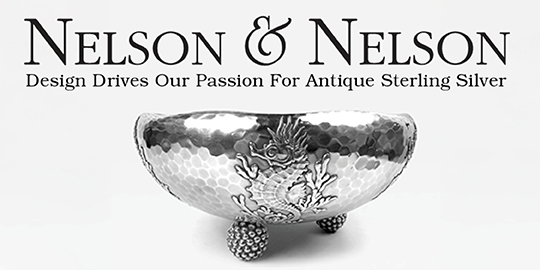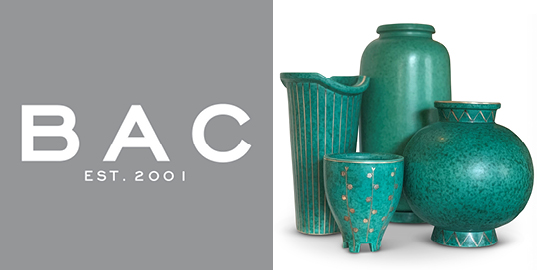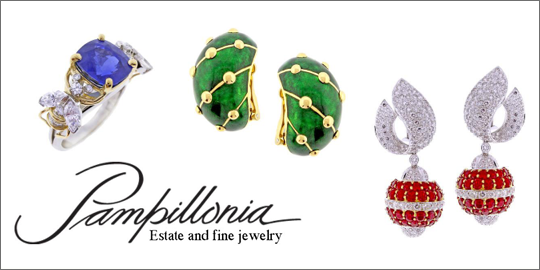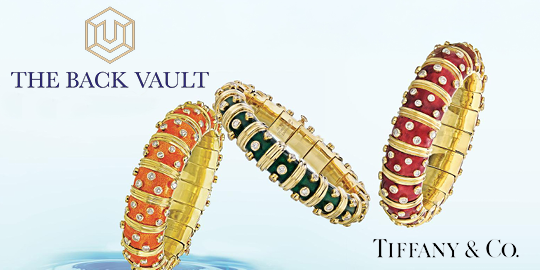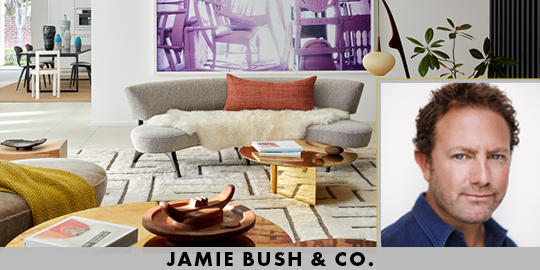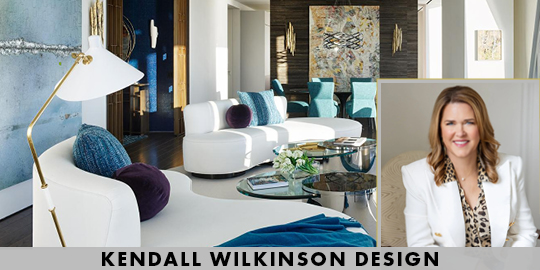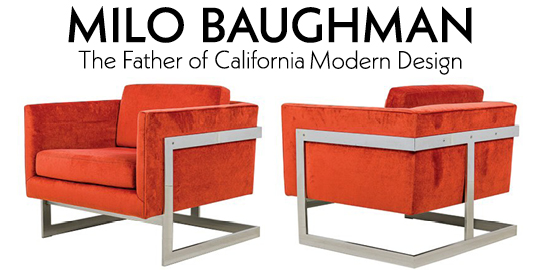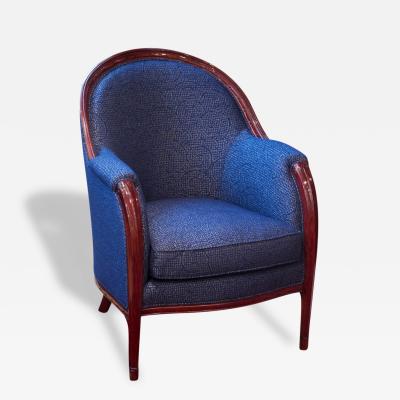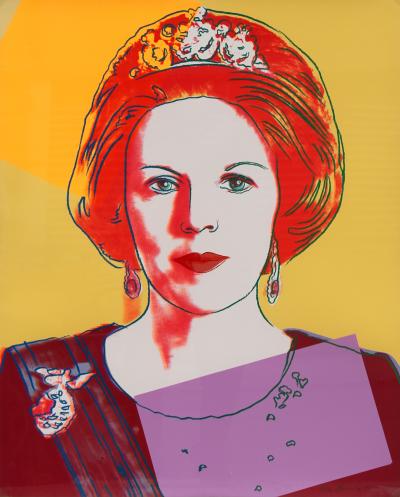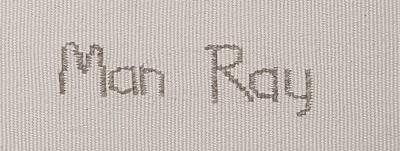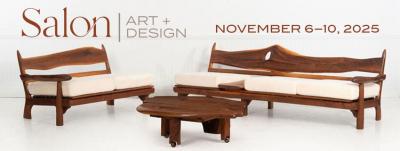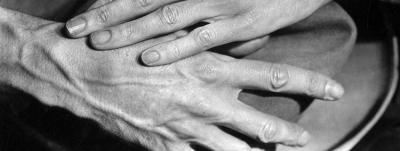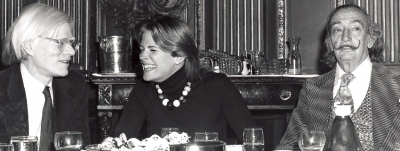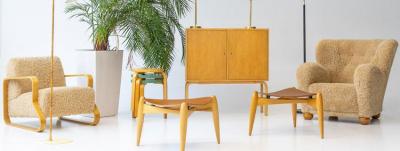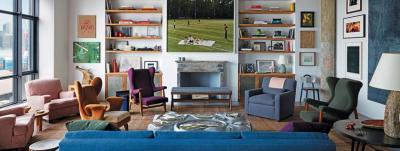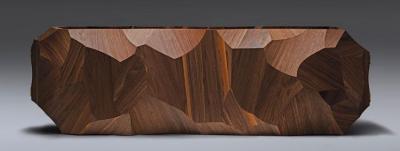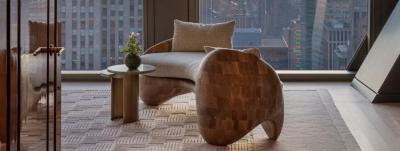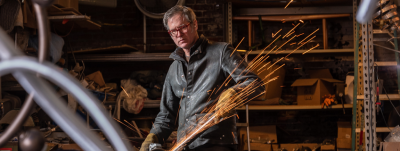A Masterful Mix of the Centuries
Exceptional taste and an unerring eye have guided the formation of this multidimensional collection. Behind the brick façade of the elegant neo-Georgian house, a masterful mix of furniture and objects from antiquity to the twenty-first century makes for a comfortable, harmonious interior.
The aesthetic of juxtaposing period furnishings with modern art — and myriad genres in between — prevails throughout the house. In the two-story entry hall, a Spanish mahogany and marquetry console table is paired with the Hans Hoffman painting Secret Source; the colors of a Kangxi porcelain famille verte bowl resonate with the painting. And that is just one vignette.
|
|
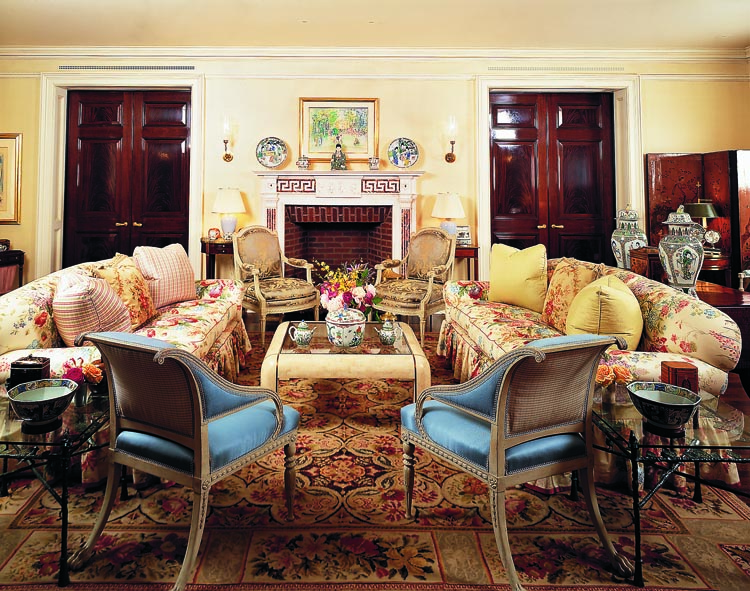
- A pair of iron Giacometti side tables came from Michel Giraud in Paris, and an early 1960s travertine and glass coffee table is by the German-born furniture designer Karl Springer. Georgian armchairs, from the Chinese Porcelain Company, contemporary sofas, and a pair of Swedish chairs are all upholstered in fabrics whose colors are drawn from the famille verte porcelain that Ralph M. Chait Galleries supplied. A joyous Raoul Dufy watercolor came from Ruth Silberstein.
The couple bought the residence in the fall of 1999, several years after they married and blended their families of her two daughters and his daughter and son. They spent the next five and a half years in a process of meticulous restoration and renovation, working with interior designer Greg Jordan of New York, known for creating luxurious spaces meant to be lived in. After Jordan’s sudden death, the couple continued with his senior designers Rob Southern and Eddie Lee, each of whom had established his own firm. The projects encompassed more than introducing furnishings, color, and fabrics. It also called for the replacement of the floors throughout the house and matching all the exterior brick work. Southern and Lee installed several gallery-like spaces to accommodate the couple’s art collection. Lee describes the couple as “avid collectors.”
A greenhouse was demolished to make way for a sitting room, plus a gym and a wave pool were installed. The craftsmanship within and without is extraordinary. Very much a showplace, the house is at the same time warm and inviting, with children and friends in and out all day long.
The grounds of the property are extensive, particularly given the close proximity of the house to a nearby city. Landscape architect Gregory Lombardi was retained to restore the original Frederick Law Olmstead gardens and to design new ones to incorporate into the setting. He added heirloom and historic plantings, an English garden and such delights as a Japanese maple grove and a selection of pink and yellow tree peonies. Of one terrace (there are several) with a wall of espaliered pears, Lombardi says, “It’s one of the most favorite terraces we’ve ever done.” The pleasure of working with these clients is evident in his voice. Dropped in among the elegant, traditional gardens is a collection of contemporary outdoor sculpture, among which are cast iron animals and an oversized iron telephone. Red Grooms’ 2005 bright red Dancers, acquired from the Marlborough Gallery in New York, sashay across the lawn; George Segal’s Seated Woman is situated on a terrace bench; and Sylvie Fleury’s Mushrooms is playfully set within the grass.
|

- The couple acquired the Donald Judd horizontal aluminum geometric sculpture after seeing it at Art Basel Miami Beach. It hangs above a late eighteenth-century George III sycamore wood octagonal center table from Mallett of London, and is the perfect foil for the rare pair of famille verte kendi and a covered jug and three plates, all from Ralph M. Chait Galleries. The figure of a Chinese goddess is from J. R. Richards Asian Art, Los Angeles, California.
In addition to the skill of exceptional architects and designers, the couple has also depended on the assistance of first-rate antiques and art dealers, who continue to provide the treasures within this remarkable house. The wife adores porcelain, and, while her husband certainly appreciates it, his forte is art. She says he has an innately good eye. Together they have assembled a collection of modern and contemporary art that blends seamlessly with the antique
furnishings of the house.
The wife inherited her love of antiques from her mother who “collects beautiful, elegant pieces, mostly English.” She also inherited a highly refined appreciation for quality. She points to an English octagonal two-drawer inlaid sewing table in the living room and laughs, explaining that she wrested it from the grasp of the prominent antiques dealer who was about to purchase and remove it from her mother’s house. A number of other objects from her mother’s collection are placed within the home.
The wife’s collecting began with a passion for Chinese export porcelain, which she has been gathering for over twenty years. She drew on the designs and the soft green and rose palette from the Kangxi period (1662–1722) famille verte porcelain and Chien Lung period (1736–1795) famille rose porcelain as inspiration for the color scheme of several of the formal rooms. Many of the forms were supplied in highly desirable pairs, the famille verte by Ralph M. Chait Galleries of New York, and the famille rose by Lynda Willauer Antiques of Nantucket, Massachusetts, and Greenwich, Connecticut.
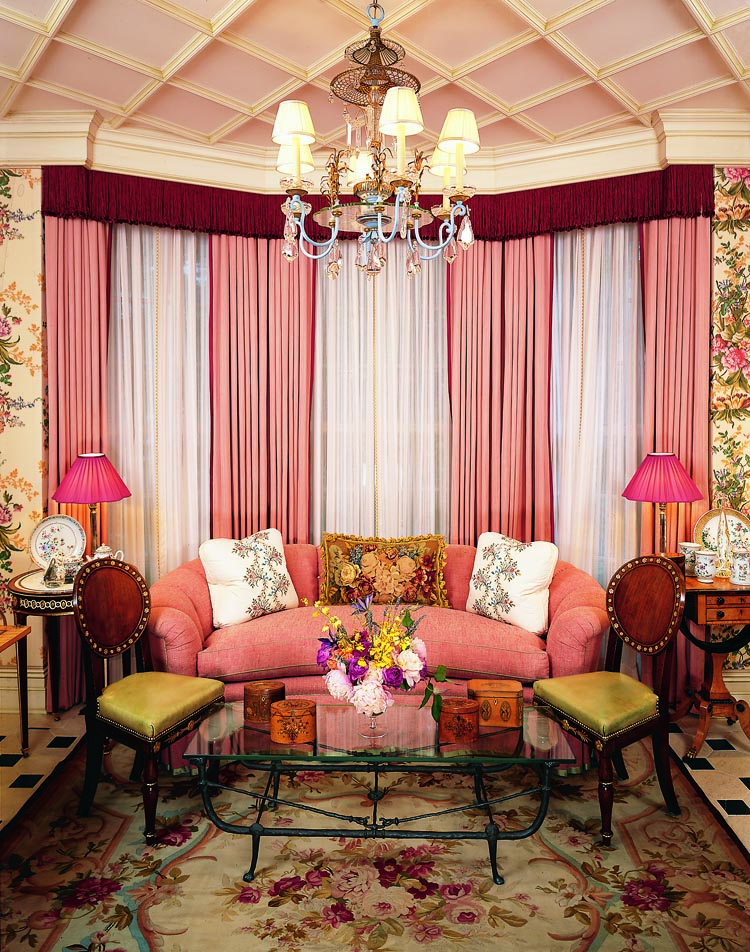
- The sitting room off the formal dining room is elegant and cozy at the same time. A cabinet (not shown) is filled with some of the tea-related objects for which the wife has a strong affinity. The soft pink tones of the room make the Giacometti cocktail table, set with tea caddies from Sallea Antiques, a standout. The sofa is flanked by a Biedermeier work table and marble-top stand.
Ceramics have pride of place in the living room, a space designed with a blend of formal and contemporary furnishings that bespeak comfort. Part of the Chinoiserie aesthetic is a rare Chinese export tilt-top table, circa 1810, decorated with scenes of lake palaces, sampans, and islands on a black lacquer ground. Antique French and English furnishings are also present. An elaborate japanned secretary, filled with Kangxi famille verte porcelain, presides over the room. One of the wife’s favorite objects, a handsome English Sheraton barometer, circa 1790, is inlaid with satinwood. She purchased it from Mallett of London, along with a pair of shell-carved looking glasses, and a pair of hall chairs.
The claret walls and burgundy leather upholstery of the formal dining room are drawn from the palette of the couple’s outstanding collection of Chinese export famille rose porcelain, here supplied by Lynda Willauer. A pair of Georgian mahogany octagonal dumb waiters flank the inlaid marble fireplace. Each displays choice examples of famille rose, including lighthouse coffeepots, Meissen-inspired teapots, and silver shape tea caddies with original lids. The couple’s collection includes desirable armorial examples such as the large pair of eighteenth-century meat dishes displayed on the sideboard, with the Benson coat of arms.
The triple pedestal English banquet table, from Sallea Antiques of New Canaan, Connecticut, breaks into three smaller tables that accommodate ten diners each. (The couple commissioned a replica from furniture conservators Fallon and Wilkinson in Baltic, Connecticut, that is used for larger groups.) The Biedermeier dining chairs came from Iliad Antik of New York. Decorative painter Iris Lee Marcus, whom the wife had heard of before they serendipitously met on an airplane, was commissioned to paint the dining room floor with geometric medallions inset with pink flowers, which relates to the palette of the porcelain.

- A collector of antique Cartier clocks, the wife has placed them on tables and chests throughout the house. One of her favorites is the sublime Art Deco example she purchased from Hancocks of London, which keeps time on the mantel in the Art Deco salon. The floral arrangements were created by Boston area designer Domenic Cambino.
The wow factor explodes out of an Art Deco sitting room resonant of a lounge aboard the Normandie, and edgy in blue, soft aqua, and black; a sinuous Steuben figure of Moby Dick echoes the maritime aspect of the room. This is the couple’s favorite space, and it’s not to hard to see why. Honeymooning in Paris over a dozen years ago, they visited the flea markets and fell in love again—with Art Deco furniture from Jean-Paul Costey in the Marché Serpette. They began to buy, and when they renovated the house the Art Deco room was born. A sleek and richly grained Deco martini bar is a complement to the larger counter bar across the room that is fitted with martini-glass bar stools. In the center of the room a honey color burlwood Art Deco table breaks into five pieces. The Art Deco fireplace surround, like most of the others in the house, came from London. It is flanked by French glass and chrome lighting fixtures from Jean-Paul Costey of Paris. A Cartier Art Deco clock keeps time on the mantel; the wife has several elsewhere in the house as they are a favorite decorative device.
|
|

- The grand family room, lined with specially milled tongue and groove paneling, is the perfect setting for the couple’s frequent entertaining. Dominating the space is Damien Hirst’s one-and-a-half story Triethyl Orthoacetate. Placed above the fireplace, it demands the attention of all who enter the room. The couple has achieved a casual atmosphere in this space, juxtaposing eighteenth- and nineteenth- century English and French furniture with modern paintings like Hirst’s Triethyl and Andy Warhol’s dollar bill series. The large-scale Hirst is a favorite of the couple’s, who saw the painting at Art Basel Miami Beach and later acquired it from White Cube Gallery. It sets off a Tang horse on the mantel below, which as with all the ancient pottery in the collection, is from J. R. Richards.
The couple loves movies and the theater so much that they installed a comfortable ten-seat theater in the finished basement. Their celebrity series of vintage black and white theatrical photography fills the stairwell outside the theater, much of it from Holden Luntz Gallery of Palm Beach. Other sources for the photographs are Howard Greenburg Gallery and Marla Hamburg Kennedy Photographs, both of New York City. A group of drawings by Al Hirshfeld and inscribed to the couple lines one of the hallways. The drama of these images is balanced by a serene group of contemporary Chinese photographs remarkable for the stillness they convey.
The concept of a “rec room” takes on a whole new meaning in this house. The owners have installed a mid-twentieth-century-style diner in the basement and furnished it with a retro pool table, bar, jukebox, vintage Coke machine, and a vintage scale, probably from a carnival, that tells weights for 25 cents. Red upholstered bar stools and chairs contrast with a black and white tile floor. Bold graphics adorn the walls, such as a print of Roy Lichtenstein’s 1965 The Melody Haunts My Reverie. This space is where the children relax with friends; although some evenings the couple will pull up a seat at the soda fountain themselves.
Elise Abrams, Great Barrington, Mass.
Ralph M. Chait Galleries, N.Y.
Hancocks of London
Jeffrey Purtell, Portsmouth, N.H.
J. R. Richards, Los Angeles, Calif.
Sallea Antiques, New Canaan, Conn.
Charles Washburne, Solebury, Pa.
Lynda Willauer, Nantucket,
Mass. & Greenwich, Conn.





